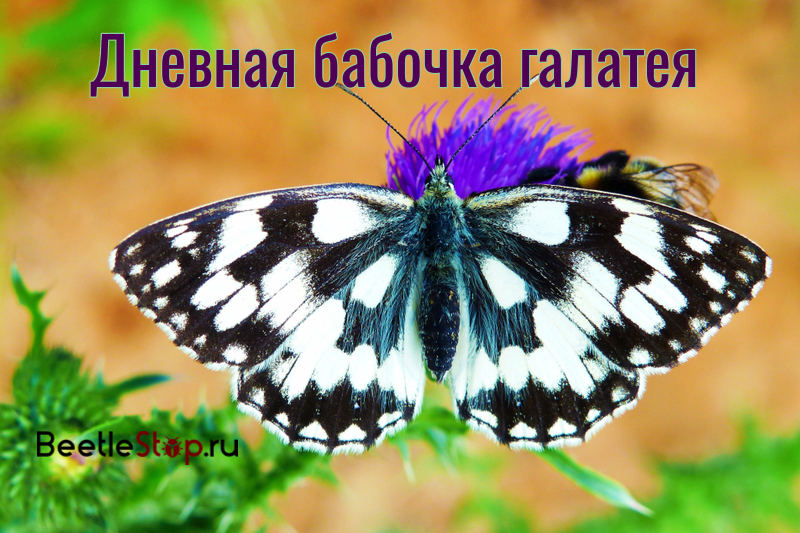Butterfly Galatea - the beauty of black and white contrast
The motley butterfly Galatea is a species common in the vastness of the Palearctic. Its representatives live in thickets of shrubs, on forest edges, river banks. Moths of the genus mottled eyes are painted in contrasting black and white colors. They feed on the nectar of a thistle, yarrow, thyme. Galatea caterpillars fall into diapause immediately after emergence from an egg. Larvae develop and feed only the next year.

View description
Galatea diurnal butterfly (Melanargiagalathea) belongs to the family of marigold or satiris (satire), the genera of the mottled-eyed. She received her Latin name after the ancient Greek sea god Nerea. Galatea was the personification of a calm sea. The smooth measured flight of the moth is comparable to the movement of light waves.
The wingspan of a moth is 50-55 mm, the length of the front wing is 23-27 mm. On the upper side of the wings there is a pattern of black and white spots. On the reverse side of the wings of the Galatea butterfly, light fields prevail. The eyelet pattern, located at the edge of the wing, distinguishes the multi-eye from the whites. In females, the lower part of the wings may have yellowish scales.
The head is round, pubescent with hairs. The eyes are large, complex, markedly visible on the sides of the head. The faceted type of structure provides a mosaic perception of the image. The antennae are club-shaped, their club gradually thickens towards the edge, its last segment is colored orange or yellow. Antennas located between the crown of the head and forehead are the organs of touch that pick up odors. The sucking mouth is represented by a proboscis. In a calm state, a long tube is folded in the form of a spiral.
Interesting fact. For motley butterflies, two colors are most attractive - blue-violet and red.
Distribution area
Marigold galatea is found in most of Europe, in the central, eastern and southern parts. Butterflies live in the UK, but are absent in Denmark and Finland. The species is common in northern Africa. In this region, insects are distinguished by reduced wings and a lighter color. Speckled eyes live in Asia Minor and the Middle East to Iran. In Russia, butterflies are found everywhere up to the South Ural region, and are found in large numbers in the Caucasus.
Lifestyle
Insects develop with complete transformation. The first phase is the egg, followed by the caterpillar and pupa. The last stage of metamorphosis is the imago. For a year, Galatians give one generation. Butterflies are active at noon, prefer to fly and feed on hot days. The largest number of adults occurs from late June to August. The habitats of the species are light forests, meadows, shrubs, banks of rivers and lakes, gardens and parks.
Propagation Features
For a short period of life, the Galatheas manage to give life to one generation. The number of eggs in the clutch is difficult to calculate due to the characteristics of the ovipositor. They are white, spherical in shape, 1 mm in diameter. The embryonic period lasts 3 weeks. Before the offspring appears, the shell acquires a pinkish tint.
Interesting fact. Galatea has an unusual way of laying eggs. The female dumps them while sitting on the grass or during a flight. Eggs are not attached to anything; they fall on grass or ground.
The caterpillar appears to fall asleep immediately.The insect does not eat on plants, having eaten the shell of the egg, it hides among the grass. In spring, the larvae wake up and start feeding. They like fresh green grass:
- wheat grass;
- fescue;
- timothy grass;
- bluegrass;
- the rump is straight.
Caterpillars are active at night, during the day they hang upside down on grass blades. Eat exclusively in the dark. They are born 3 mm long, by the last fourth age they grow up to 28 mm. There are two forms of caterpillar coloring: brownish beige and green. Several bright bands pass along the body. A dark longitudinal line runs along the back. The integument is dotted with small white warts, from which thin short hairs grow. The head is large, round, covered with hairs. The mouth apparatus is gnawing.
Having finished feeding, the larva slides to the roots of the fodder plant, where it prepares for pupation. The process begins in late May or early June. Pupa is ovoid, smooth, beige or tan. The stage will last 3 weeks. A pupa can lie on the surface of the earth, be buried in loose soil or under moss. Sexual dimorphism of butterflies is already evident at this stage, pupae of males are 12 mm long and females are 15 mm long.
Before the appearance of the imago, the coloration of the pupa darkens in the region of the head, wings, and chest. Young moths climb plants to spread their wings. In early July, in warm sunny weather, among the grass, you can see a lot of black and white butterflies.

